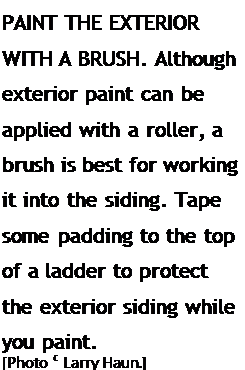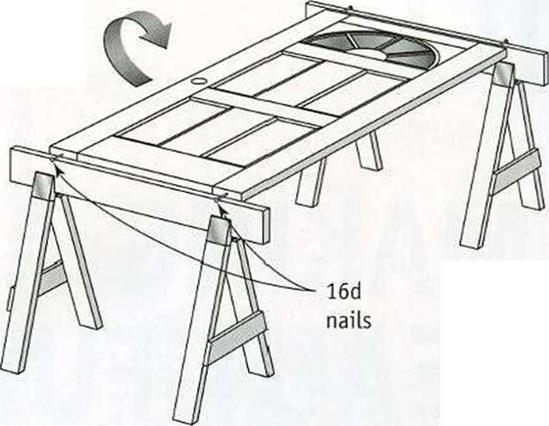Choose an exterior finish
Wood siding, such as shingles or clapboard, is often better off when finished with stain rather than with paint. Solid-color exterior stain gives wood a paintlike appearance, hut it does not crack or peel the way paint can. To let more of the wood grain show through, use semitransparent stain, which is available in many wood tones and colors.
Whether you choose paint or stain, make sure you buy a good-quality finish that is rec-
SET THE NAILS. Before painting any trim, use a hammer and nail set to drive all nails about Vs in. below the surface of the wood. Fill the holes with wood putty and sand them smooth.


ommended for the use you have in mind. For example, you don’t want to paint a deck with porch enamel or use interior trim paint on exterior wood. The pressure-treated lumber used on many decks needs a penetrating sealer or stain rather than paint. Upright pressure – treated porch posts can be painted or stained with a solid color once the wood is clean and dry. Find out which brands and formulations knowledgeable painters and paint suppliers in your area recommend.
Do the prep work for exterior finishes
Exterior siding and trim must be painted on all sides, not just on the surfaces that will be
exposed to the weather. Back-prime the trim before installation. On doors and windows with wood casings, make sure you back-prime all casings before installing the unit.
Take the time to fill all nail holes with exterior-grade wood putty. Don’t caulk under the lap between siding boards or where siding meets trim because you don’t want to trap water behind the siding. There is no need to caulk or seal under the lap between siding boards because any moisture that gets behind the siding can drain out between the laps. Always use a good-quality, long-lasting, paint- able, exterior-grade caulk. Mask and cover any decks or railings to protect them from drips and spills. Cover the foundation or walkways to keep paint from staining the concrete. Take the time to do it right. There is no excuse for being sloppy with paint. Drops of paint on a wood deck or concrete foundation will look bad for years to come.
Much can be done with exterior paint to give a house a classy style. There is an old house in our neighborhood that has just been repainted lavender with light-violet trim. Now, this may not be your choice of colors, but it brightens up our neighborhood in a nice way. 1 like it better than the Coos Bay gray that makes so many buildings look like army barracks. A good
![]()
You can’t have too many volunteers when it’s time to paint. . .
We use brushes and rollers of all different sizes. . .
Painting a new house is great because you don’t n to worry about getting paint on carpets and furniture People with rollers paint the walls and ceilings qu but it’s just as satisfying to work on trim with a brus
![]()




choice of colors can make a home warm and inviting. Some paint dealers have a computer program that shows you what different color combinations will look like on your house.
Give your house a virtual paint job to test out various color schemes.
Once you have selected the color, try rolling paint on lap siding with a roller that matches the width of the laps. Once the paint has been rolled on, it must be brushed in to make sure every crack and crevice is covered properly. Take special care when painting the bottom edges of siding. These edges must be well coated because it is where moisture and ice gather.
Latex paint dries rapidly in hot weather, so don’t roll on too much paint before you go back over it with a brush. Remember, too, that most paints require a wall temperature of at least 50°F or so for good adhesion, so don’t paint if the weather is cooler than that.
Completely paint or stain the siding before you tackle the exterior trim, just as you did on the interior. Use a good brush and a steady hand to leave a neat-looking job. Doors get a lot of use, so it’s best to give them at least a couple of coats on top of the primer. The metal-clad exterior doors that are often used unaffordable houses come with a prime coat. You may want to use a higher gloss paint on doors because it is easy to clean.
Instead of trying to paint doors in place, take them down and remove all the hardware. Put the hardware for each door in a small plastic bag, label the bag, and store it in a kitchen drawer. Label the door, too. The top edge is a good place to write the door’s location. Drive nails or screws into the top and bottom edges, then set the door across a pair oi sawhorses (see the illustration above). After painting one side, flip over the door and paint the other side. Set the door aside, resting it on the nails, while you paint another door. Wait
■
until the first coat is dry, then apply a second coat, brushing out any streaks or drips. When you’re done, remember to put a bit of caulk in the top nail holes so water can’t enter.
Door jambs are also easier to paint when there’s no door in the way. On some exterior entries, weatherstripping is installed on the door; on others, it’s installed on the jamb. Either way, it’s usually best to remove weatherstripping before painting instead of trying to paint around it. Getting paint on weatherstripping can prevent it from sealing properly. If the weatherstripping is damaged or difficult to reinstall, just buy new material. It is generally inexpensive and is important for sealing the interior of the house from the elements.
Once you are finished painting, use a small piece of cardboard to scrape all unused paint into one can. Save some paint for later touch-up work. A contractor I know takes leftover cans of latex paint, stirs them together, and uses the mixture as back-primer for the next job. Some cities have a site where you can drop off paint for recycling. Otherwise, take unused paints, stains, and solvents to a hazardous-waste facility. Give the earth a break. Don’t dump toxic materials on the ground or down the sink.
|
і |






Leave a reply